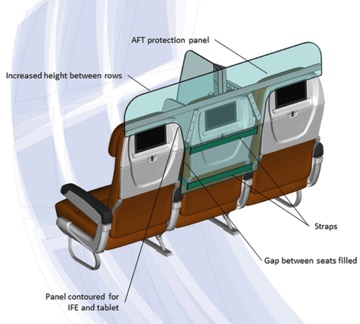Flying during the middle of a pandemic probably isn’t a great idea. But eventually, as they lift stay-at-home restrictions and the world returns to somewhat normal travel patterns, there must be a way to facilitate airline passengers.
Leaving the middle seat empty seems to be a good option, and a typical 737-700, for instance, could still hold 99 passengers if the middle seats are eliminated (or at least kept empty).
French aeronautical engineer Florian Barjot has run with that idea, coming up with “PlanBay,” which sacrifices the middle seat for a pane of plexiglas. Since there’s only about 3.5 feet of space from the window seat to the middle aisles on most commercial aircraft, this addition could make social distancing much more likely.
“Modern aircrafts have efficient air systems that prevent the contagion from one person to the entire passenger population, but the health authorities recommend one-meter distancing, which is hardly achievable in economy class, even with an empty middle seat,” Barjot writes on the PlanBay website. “In order to improve the distancing, I imagined this removable kit for an unused seat, that can be used temporarily for the time of an epidemic outbreak and the recovery phase.”
Barjot’s concept just may work, because it doesn’t seek to rehaul the entire interior of a jet—instead, it proposes a removable, temporary solution. Barjot also claims the device doesn’t cost much, which is ideal for the airline industry, as it’s currently under massive financial strain.

PLANBAY

To start, because the rows of seats on an airplane aren’t six feet apart—to which anyone with long legs can attest—PlayBay uses a plastic panel above each row to extend the height of the seats. The panel extends down the backside of the middle seat and is strapped into place so it hugs the upright tray.
The piece is just wide enough that it can also cover the gaps between the middle seat and the window and aisle seats. This way, if a person sitting behind you coughs, you don’t have to worry as much.
From the front angle, a plastic partition runs right down the middle of the center seat to separate the person sitting in the window seat from the person in the aisle seat. This is optimal because otherwise, to keep people six feet apart, it would be necessary to remove some components. In another design, for example, some seats are rear-facing to create more space. In Barjot’s version, there’s no need for that.
While Barjot has applied for a patent, it’s still not clear whether his idea will soar. In a statement on post-COVID-19 air travel, the International Air Transport Association (IATA)—the industry’s trade association—directly heeds against such designs.
The IATA “supports the wearing of face coverings for passengers and masks for crew while on board aircraft as a critical part of a layered approach to biosecurity to be implemented temporarily when people return to traveling by air,” according to the statement, but “does not support mandating social distancing measures that would leave ‘middle seats’ empty.”
Part of the concern is that leaving middle seats empty—in turn, decimating at least one-third of potential profit—will jack up the price of a ticket. That’s not a risk the IATA wants airlines to take in the midst of a financial crisis, where travelers are already weary.
One thing is for sure though/ Flying will never be the same again!










